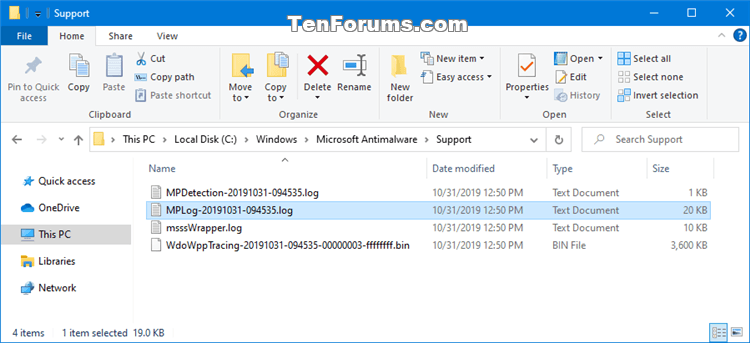
- WINDOWS DEFENDER OFFLINE ENCRYPTED DRIVE DRIVERS
- WINDOWS DEFENDER OFFLINE ENCRYPTED DRIVE WINDOWS 10
- WINDOWS DEFENDER OFFLINE ENCRYPTED DRIVE SOFTWARE
- WINDOWS DEFENDER OFFLINE ENCRYPTED DRIVE WINDOWS 8
Initially, its "Settings" dialog box was replaced by a dedicated page in the Settings app. Starting with Windows 10, Microsoft began to transfer the control of Windows Defender out of its native client. It switches itself off upon installation of a third-party anti-virus package.
WINDOWS DEFENDER OFFLINE ENCRYPTED DRIVE WINDOWS 8
In Windows 8 and Windows 10, Windows Defender is on by default. MSE itself does not run on Windows versions beyond 7. In Windows 8, Microsoft upgraded Windows Defender into an antivirus program very similar to Microsoft Security Essentials for Windows 7 and using the same virus definition updates. Upon installation, Microsoft Security Essentials disabled and replaced Windows Defender. In Windows Vista and Windows 7, Windows Defender was superseded by Microsoft Security Essentials, an antivirus product from Microsoft which provided protection against a wider range of malware. Windows Defender was released with Windows Vista and Windows 7, serving as their built-in anti-spyware component. It supports Windows XP and Windows Server 2003 however, unlike the betas, it does not run on Windows 2000. On October 24, 2006, Microsoft released Windows Defender. German and Japanese versions of Windows Defender (Beta 2) were later released by Microsoft. Microsoft removed the System Inoculation, Secure Shredder and System Explorer tools found in MSAS (Beta 1) as well as the Tracks Eraser tool, which allowed users to easily delete many different types of temporary files related to Internet Explorer 6, including HTTP cookies, web cache, and Windows Media Player playback history.

However, Windows Defender (Beta 2) did not contain some of the tools found in Microsoft AntiSpyware (Beta 1). Beta 2 also requires Windows Genuine Advantage (WGA) validation. Also, since beta 2, the program works as a Windows service, unlike earlier releases, which enables the application to protect the system even when a user is not logged on. This improved the application's performance.

The core engine was rewritten in C++, unlike the original GIANT-developed AntiSpyware, which was written in Visual Basic. It featured the program's new name and a redesigned user interface. Windows Defender (Beta 2) was released on February 13, 2006.
WINDOWS DEFENDER OFFLINE ENCRYPTED DRIVE SOFTWARE
The first beta release of Microsoft AntiSpyware from Januwas a repackaged version of GIANT AntiSpyware There were more builds released in 2005, with the last Beta 1 refresh released on November 21, 2005.Īt the 2005 RSA Security conference, Bill Gates, the Chief Software Architect and co-founder of Microsoft, announced that Windows Defender (formerly Microsoft AntiSpyware prior to November 4, 2005) would be made available free-of-charge to users with validly licensed Windows 2000, Windows XP, and Windows Server 2003 operating systems to secure their systems against the increasing malware threat. While the original GIANT AntiSpyware officially supported older Windows versions, support for the Windows 9x line of operating systems was later dropped by Microsoft. The company's acquisition was announced by Microsoft on December 16, 2004. Windows Defender was initially based on GIANT AntiSpyware, formerly developed by GIANT Company Software, Inc. Microsoft AntiSpyware Beta 1 (Version 1.0.701) running Windows XP.

WINDOWS DEFENDER OFFLINE ENCRYPTED DRIVE WINDOWS 10
In the Windows 10 Anniversary Update, a new logo is introduced and a pop-up notification will appear to announce the results of a scan, even if no viruses are found. In Windows 10, Windows Defender settings are controlled in the Windows Defender Security Center. It also uses the same anti-malware engine and virus definitions from MSE. Protection against viruses was subsequently added in Windows 8 which resembles Microsoft Security Essentials (MSE).
WINDOWS DEFENDER OFFLINE ENCRYPTED DRIVE DRIVERS
Windows Defender featured an integrated support for Microsoft SpyNet that allows users to report to Microsoft what they consider to be spyware, and what applications and device drivers they allow to be installed on their systems. It also has the ability to remove installed ActiveX software. It includes a number of real-time security agents that monitor several common areas of Windows for changes which might have been caused by spyware. Before Windows 8, Windows Defender only protected users against spyware.


 0 kommentar(er)
0 kommentar(er)
